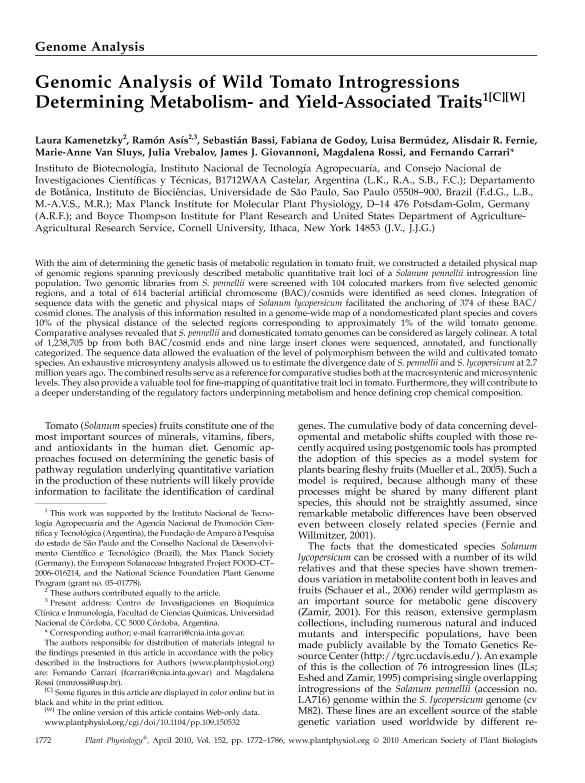Mostrar el registro sencillo del ítem
dc.contributor.author
Kamenetzky, Laura

dc.contributor.author
Asis, Ramón

dc.contributor.author
Bassi, Sebastián
dc.contributor.author
de Godoy, Fabiana
dc.contributor.author
Bermúdez, Luisa
dc.contributor.author
Fernie, Alisdair R.
dc.contributor.author
van Sluys, Marie Anne
dc.contributor.author
Vrebalov, Julia
dc.contributor.author
Giovannoni, James J.
dc.contributor.author
Rossi, Magdalena
dc.contributor.author
Carrari, Fernando Oscar

dc.date.available
2019-01-09T17:32:58Z
dc.date.issued
2010-12
dc.identifier.citation
Kamenetzky, Laura; Asis, Ramón; Bassi, Sebastián; de Godoy, Fabiana; Bermúdez, Luisa; et al.; Genomic analysis of wild tomato introgressions determining metabolism-and yield-associated traits; American Society of Plant Biologist; Plant Physiology; 152; 4; 12-2010; 1772-1786
dc.identifier.issn
0032-0889
dc.identifier.uri
http://hdl.handle.net/11336/67777
dc.description.abstract
With the aim of determining the genetic basis of metabolic regulation in tomato fruit, we constructed a detailed physical map of genomic regions spanning previously described metabolic quantitative trait loci of a Solanum pennellii introgression line population. Two genomic libraries from S. pennellii were screened with 104 colocated markers from five selected genomic regions, and a total of 614 bacterial artificial chromosome (BAC)/cosmids were identified as seed clones. Integration of sequence data with the genetic and physical maps of Solanum lycopersicum facilitated the anchoring of 374 of these BAC/ cosmid clones. The analysis of this information resulted in a genome-wide map of a nondomesticated plant species and covers 10% of the physical distance of the selected regions corresponding to approximately 1% of the wild tomato genome. Comparative analyses revealed that S. pennellii and domesticated tomato genomes can be considered as largely colinear. A total of 1,238,705 bp from both BAC/cosmid ends and nine large insert clones were sequenced, annotated, and functionally categorized. The sequence data allowed the evaluation of the level of polymorphism between the wild and cultivated tomato species. An exhaustive microsynteny analysis allowed us to estimate the divergence date of S. pennellii and S. lycopersicum at 2.7 million years ago. The combined results serve as a reference for comparative studies both at the macrosyntenic and microsyntenic levels. They also provide a valuable tool for fine-mapping of quantitative trait loci in tomato. Furthermore, they will contribute to a deeper understanding of the regulatory factors underpinning metabolism and hence defining crop chemical composition. © 2010 American Society of Plant Biologists.
dc.format
application/pdf
dc.language.iso
eng
dc.publisher
American Society of Plant Biologist

dc.rights
info:eu-repo/semantics/openAccess
dc.rights.uri
https://creativecommons.org/licenses/by-nc-sa/2.5/ar/
dc.subject
Tomato
dc.subject
Physical Map
dc.subject
Metabolism
dc.subject
Introgression Lines
dc.subject.classification
Otras Ciencias Biológicas

dc.subject.classification
Ciencias Biológicas

dc.subject.classification
CIENCIAS NATURALES Y EXACTAS

dc.title
Genomic analysis of wild tomato introgressions determining metabolism-and yield-associated traits
dc.type
info:eu-repo/semantics/article
dc.type
info:ar-repo/semantics/artículo
dc.type
info:eu-repo/semantics/publishedVersion
dc.date.updated
2019-01-07T13:54:56Z
dc.journal.volume
152
dc.journal.number
4
dc.journal.pagination
1772-1786
dc.journal.pais
Estados Unidos

dc.journal.ciudad
Rockville
dc.description.fil
Fil: Kamenetzky, Laura. Consejo Nacional de Investigaciones Científicas y Técnicas; Argentina. Instituto Nacional de Tecnología Agropecuaria. Centro de Investigación en Ciencias Veterinarias y Agronómicas. Instituto de Biotecnología; Argentina
dc.description.fil
Fil: Asis, Ramón. Consejo Nacional de Investigaciones Científicas y Técnicas; Argentina. Instituto Nacional de Tecnología Agropecuaria. Centro de Investigación en Ciencias Veterinarias y Agronómicas. Instituto de Biotecnología; Argentina
dc.description.fil
Fil: Bassi, Sebastián. Consejo Nacional de Investigaciones Científicas y Técnicas; Argentina. Instituto Nacional de Tecnología Agropecuaria. Centro de Investigación en Ciencias Veterinarias y Agronómicas. Instituto de Biotecnología; Argentina
dc.description.fil
Fil: de Godoy, Fabiana. Universidade de Sao Paulo; Brasil
dc.description.fil
Fil: Bermúdez, Luisa. Universidade de Sao Paulo; Brasil
dc.description.fil
Fil: Fernie, Alisdair R.. Max Planck Institute for Molecular Plant Physiology; Alemania
dc.description.fil
Fil: van Sluys, Marie Anne. Universidade de Sao Paulo; Brasil
dc.description.fil
Fil: Vrebalov, Julia. Cornell University; Estados Unidos
dc.description.fil
Fil: Giovannoni, James J.. Cornell University; Estados Unidos
dc.description.fil
Fil: Rossi, Magdalena. Universidade de Sao Paulo; Brasil
dc.description.fil
Fil: Carrari, Fernando Oscar. Consejo Nacional de Investigaciones Científicas y Técnicas; Argentina. Instituto Nacional de Tecnología Agropecuaria. Centro de Investigación en Ciencias Veterinarias y Agronómicas. Instituto de Biotecnología; Argentina
dc.journal.title
Plant Physiology

dc.relation.alternativeid
info:eu-repo/semantics/altIdentifier/doi/https://doi.org/10.1104/pp.109.150532
dc.relation.alternativeid
info:eu-repo/semantics/altIdentifier/url/http://www.plantphysiol.org/content/152/4/1772
Archivos asociados
